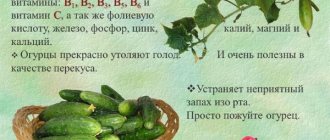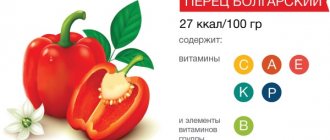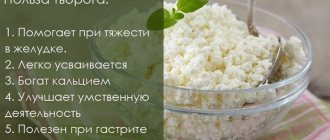Russian cheese is one of the most beloved semi-hard cheeses in our country. This product was “born” at the Research Institute of the Cheese Industry in the 60s of the last century. Once on the shelves, Russian cheese became more and more popular every year.
If immediately after the creation of the recipe, the cheese was produced by only one cheese-making plant in Uglich, then its growing consumption forced the relevant ministry to extend the production technology to many other cheese-making plants and factories in Russia, Belarus, Ukraine and the Baltic countries, which today are the main producers of this type of cheese .
Composition of the product
The fat content of Russian cheese is 50%. At the same time, it contains a lot of protein (21-23 g/100 g) with an average fat content (30-33 g/100 g). The difference in percentage and natural fat content is explained by the fact that its percentage is determined in dry matter, and natural - in the finished product, that is, taking into account its moisture content.
Content:
- Composition of the product
- Production technology
- Beneficial features
- Possible harm
- Use in cooking
- How to select and store
Milk fat is represented to a greater extent by saturated, and to a lesser extent by mono- and polyunsaturated fatty acids. Cheese proteins are complete in nature, that is, they contain all the amino acids essential for the human body.
The composition of the finished product, in addition to proteins and fats, also includes carbohydrates (glucose, lactose), vitamins (group B), minerals and preservatives. The calorie content of this fermented milk product is 364 kcal per 100 g.
Nutritional and energy value
Calorie content and nutritional supplements per 100 grams:
| Fat content of the product, % | Number of kcal | Proteins, g | Fats, g | Carbohydrates, g |
| 50 | 363 | 24 | 30 | 0,3 |
| 45 | 497 | 23 | 45 | 0 |
| 55 | 318 | 15 | 30 | 1 |
55% fat content is often found in processed Russian cheese, which is highly not recommended when following a diet.
Production technology
Russian cheese is produced according to GOST. This is one of those cheeses that is characterized by a high degree of lactic fermentation and a low second heating temperature.
Another peculiarity of the industrial production of this cheese is that mesophilic lactic acid streptococcal starters are used to ferment milk, and during the ripening process the heads change temperature conditions three times (10-12°, 14-16° and again 10-12°C).
The production process includes several successive stages:
- Cleaning and cooling of milk to +6…+8°С (to prevent microbial contamination).
- Maturation of milk (to increase its acidity). To do this, cooled milk is kept for 10-14 hours at a temperature of +10...+12°C.
- Normalization and pasteurization. Milk is normalized by fat, bringing it to the required mass fraction according to the technological instructions. Normalized milk is pasteurized in order to suppress the growth of microbes in it, inhibit existing enzymes and prepare it for coagulation. After pasteurization, the raw material is cooled to the coagulation temperature (32-34°C).
- Curdling of milk. Ferment and calcium chloride solution are added to the prepared milk. Within 25-30 minutes, a clot forms.
- Crushing the clot. After formation, the curd is cut, crushed and kneaded to obtain fine cheese grains. At this stage, about 30% of the whey is removed.
- Second heating. When producing Russian cheese, it lasts 15-30 minutes at a temperature of 38-41°C. The cheese grain is partially salted.
- Dehydration. After heating, the grain is kneaded again for 30-50 minutes. At the same time, its acidity is controlled.
- Head molding. The dried grain is fed into a molding machine to form a layer, which is cut into pieces of the required size. These pieces are placed in molds, in which they are self-pressed for 25-30 minutes. After this, the heads are numbered with plastic numbers.
- Pressing. The formed heads are fed under the press for 1.5-4 hours.
- Salting. Salting of Russian cheese is carried out by immersing the heads in a circulating brine at a temperature of +8...+12°C for 3-5 days.
- Maturation. After salting, the heads are dried (2-3 days) and sent to maturation chambers for 1.5-2.5 months. After they are ripe, the heads are washed, labeled, packaged in plastic film or coated with paraffin.
This long technological process for making Russian cheese gives it a delicate texture and a pleasant sour aftertaste, which sets it apart from other semi-hard varieties. On the cut it has a beautiful fine-bubble pattern.
Vitamin content
Table 1
| Vitamins | Content | Daily norm |
| C (ascorbic acid) | 0.7 mg | 1 % |
| A (retinol) | 288 mcg | 28.8 % |
| E (α-, β-, γ-tocopherols) | 0.5 mg | 5 % |
| D (lamisterol) | 0.96 mcg | 38.4 % |
| B1 (thiamine) | 0.04 mg | 2.67 % |
| B2 (riboflavin) | 0.3 mg | 16.67 % |
| B3 (PP) (nicotinamide) | 6.1 mg | 32.11 % |
| B4 (choline) | 15.4 mg | 3.08 % |
| B6 (pyridoxine) | 0.1 mcg | 5 % |
| B9 (folacin) | 23.5 mcg | 11.75 % |
| B12 (cobalamin) | 1.5 mcg | 50 % |
Rossiyskiy cheese contains vitamins with high and low levels, if we consider them according to the approved standards for the significance of the nutritional value of the product.
At the highest level of importance in the food value chain are:
- A, takes part in all functions of the body related to its growth and proper metabolism, preserves the structure of the cornea of the eye.
- D, takes part in the formation of bone and dental tissue.
- B2, maintains body tone.
- PP, participates in the formation of hemoglobin.
- B9, supports the hematopoietic and digestive system.
- B12 is involved in many metabolic processes in the body.
Vitamins of low content include:
- C, takes part in the redox processes of the body, raises the tone of the body, strengthens the immune system.
- E, keeps the muscular system in good shape.
- B1, required to normalize the nervous and muscular systems.
- B4, is involved in the biosynthesis of heme and proteins, cell proliferation, and tissue respiration.
- B6, participates in the metabolism of lipids and amino acids.
Beneficial features
Russian cheese is a source of healthy, complete animal protein. At the same time, in order to fill the daily need for basic essential amino acids, an adult needs to eat only 120-140 g of this delicious fermented milk product, for example, in the form of cheese sandwiches for breakfast.
Consuming it in the morning allows you to level out the fairly high calorie content of cheese.
Being a source of well-absorbed calcium, this product is useful for the musculoskeletal system, especially during such periods of life as childhood, pregnancy, breastfeeding, menopause, and also after injuries to bones or joints.
The acidity of mature cheese is 5.25-5.35 pH, which, with moderate consumption of this product, has a beneficial effect on digestion processes in the intestines. Lactic acid and vitamins help restore normal intestinal microflora, fight intestinal dysbiosis and group B hypovitaminosis.
The rich vitamin and mineral composition of the finished product has a beneficial effect on metabolic processes in the human body, thereby improving brain activity, reproductive function, and the condition of the skin and its appendages.
The iron contained in cheese, together with B vitamins (folic acid, cyanocobalamin), stimulates hematopoiesis, so this product is useful to use for anemia, weakened immunity, exhaustion, after long-term and infectious diseases.
Saturated fatty acids in milk fat are used by the body for the synthesis of cell wall phospholipids, as well as steroid hormones - sex and adrenal hormones.
Composition of Russian cheese:
Vitamins:
| Vitamin: | WITH | IN 1 | AT 2 | RR | E | A |
| in mg. per 100 grams | 0.7 | 0.04 | 0.3 | 6.1 | 0.5 | 0.28 |
Minerals:
| Mineral: | Calcium | Phosphorus | Magnesium | Potassium | Sodium | Iron |
| in mg. per 100 grams | 880 | 500 | 35 | 88 | 810 | 1.0 |
It is used to prepare various snacks - cheese rolls with vegetables and garlic, mushrooms stuffed with cheese, tomatoes, baked peppers, eggs, tartlets, pancakes.
Various hearty, puff salads with mushrooms, meat, ham, squid, shrimp, potatoes, carrots, fresh and pickled cucumbers, tomatoes, onions, garlic, etc. are prepared with cheese.
It is suitable for preparing meat samples, chops, baked in the oven, cheese pies and snack pies - shortbread, yeast, puff pastries.
Possible harm
In addition to its benefits, Russian cheese can also have a harmful effect on the human body. First of all, this concerns its use in large quantities. Its fat and calorie content does not allow it to be called a dietary product, so it should not be included in the daily menu for overweight people, as well as those who are trying to lose weight.
A large amount of protein in cheese increases the load on the pancreas, liver and kidneys, so cheese is not recommended for people suffering from diseases of the pancreas, liver and urinary system. A protein load is fraught with an increase in the level of purines and uric acid in the body, so Russian cheese should not be eaten by people suffering from gout and urolithiasis.
Best materials of the month
- Coronaviruses: SARS-CoV-2 (COVID-19)
- Antibiotics for the prevention and treatment of COVID-19: how effective are they?
- The most common "office" diseases
- Does vodka kill coronavirus?
- How to stay alive on our roads?
Due to the low pH, fermented milk products are contraindicated for use by patients with gastritis with high acidity and ulcers.
Cheese contains a lot of table salt, which is harmful for inflammation of the stomach and intestinal mucosa, and is also harmful for hypertensive patients, so their consumption of this product must be reduced to a minimum.
History of Russian cheese
The variety was developed in the Soviet Union in 1960 by the Institute of Cheese Industry.
The production of Russian cheese first began at a factory in the city of Uglich. From this enterprise the product went directly to the shelves of domestic grocery stores. Affordable price and high quality quickly made it a product of mass demand. Advertising - Continued below
Due to high demand, Russian cheese was produced in volumes of up to 85 thousand tons annually. None of the other varieties could compare with it in this regard. Gradually, the Uglich plant transferred the technology for making such a popular cheese to other cheese-making enterprises, since it could no longer cope with the ever-increasing production volumes. Decades have passed, but Russian cheese is still no less loved by domestic consumers.
Use in cooking
Due to the fact that Russian cheese is tasty and affordable, it is widely used in cooking in our country.
The fat content of the product determines its ability to melt well, so it is grated for breading, pizza and casseroles, as well as:
- eaten as a separate snack;
- place on a cheese plate;
- added to salads, appetizers, side dishes;
- soups are made from it;
- used as a filling in baked goods.
This type of cheese, thanks to its delicate sourness, goes well with nuts, olives, grapes, berries, honey, coffee, and wine.
What wine goes with Altai cheese
In the classical sense, Russian cheese does not belong to those varieties that are often consumed for aesthetic taste reasons. But still, if you only have it on hand, and you really want to feel like you’re on a Parisian lawn with wine and a crispy, aromatic baguette, then you can try the following options:
- light fruity dessert wine. It has moderate astringency and a mild herbal flavor. Dessert wine goes well with almost any type of cheese and diversifies the taste sensations from its consumption.
- Vintage port with a sour-fruity aroma and taste and a sweet, recognizable aftertaste. Just as in the case of dessert wine, most cheeses go well with port wine, and Russian cheese is no exception.
The benefits and harms of cheese
Dairy products have always been valued for their high calcium and potassium content. Eating cheese stimulates the heart muscle, strengthens bones and teeth, and promotes the structure of all cells of the human body. Protein, which is easily digestible, actively participates in the formation of internal organs. Amino acids control muscle condition and help the body resist viruses and infections. B vitamins help cope with stress and promote recovery from anemia, hepatitis, and other diseases.
Unfortunately, it has been proven that consuming cheese in excess can cause a person not only benefit, but also harm. Cheese contains beef fat, which is difficult for the body to digest and increases cholesterol levels in the blood. People suffering from liver and pancreas diseases do not consume it, since the high protein content increases the load on these organs. Excessive consumption leads to problems in the digestive system and constipation.
Fact!
Russian cheese helps to quickly and effectively restore physical and mental strength after strenuous exercise.
Product Features
Cheese "Russian" (calorie content of the product is given below in the article) is a semi-hard variety of yellowish color with a delicate texture, a slightly sour aftertaste and many small holes on the cut. The product is manufactured using GOST R 52972-2008 technology, approved in 2010.
Cheese production is based on the pasteurization of fresh cow's milk, carried out with the participation of sourdough and rennet enzymes. In accordance with GOST standards, the fat content of the product is 50% + -1.5%, and the ripening period is 65-70 days.
The recipe was first created and tested in the 60s. of the last century by the All-Union Butter and Cheese Research Institute of the USSR. Customers liked the new product so much that production was gradually expanded, reaching 86,000 tons of cheese per year by 1983. After Perestroika, in addition to the Russian Federation, all CIS countries established production of the “Russian” variety, trying to maximally improve the technology established by GOST.











